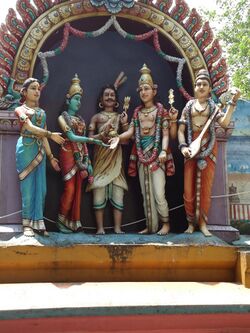Religion:Sundaravalli
| Sundaravalli | |
|---|---|
Goddess of Free Will and Desire | |
 Murugan weds Sundaravalli | |
| Venerated in | Vaishnavism, Shaivism |
| Abode | Vallimalai, Skandaloka |
| Weapon | Bow and arrow |
| Animals | Doe |
| Symbol | Creeper |
| Texts | Skanda Purana |
| Gender | Female |
| Festivals | Thaipusam |
| Personal information | |
| Parents | |
| Siblings | Devasena |
| Consort | Kartikeya |
Sundaravalli (Tamil: சுந்தரவள்ளி) is a Hindu goddess, represented in Tamil tradition as the daughter of Vishnu and Lakshmi, along with her sister Amrithavalli. According to Hindu mythology, she is said to have emerged either from the joyous tears shed by Vishnu during his incarnation as Vamana, or from the light emitted from one of the eyes of Vishnu during his cosmic state.[1] She is one of the two consorts of the war god Murugan,[2] where she is referred to as Valli.[3]
Incarnation as Valli
According to Hindu mythology, Sundaravalli and her sister Amrithavalli fell in love with Murugan upon meeting him, both expressing the desire to marry him. After performing a number of penances, the war god appeared before the sisters, informing them that he was engaged in a battle against the asura Surapadman, and would only be able to meet their desires after they had reincarnated in human form.[4][page needed] Heeding his will, Sundaravalli reincarnated herself as Valli under a creeper in the Kurunji region, and was adopted as the daughter of a chieftain called Nambirajan, or Nambi. She grew up as a huntress, protecting her folk and helping to wade birds from the millet fields. After being informed by a mystic that it was her destiny to wed Murugan, she pined for him and vowed to marry no other.[5][page needed]
Murugan, having already married Amrithavalli and now residing in Tiruttani, heard tales of the huntress and sought to meet her. He first took the form of a hunter and asked for her hand in marriage. Valli refused him, ignorant of his true identity. Besotted with her, he took the form of a venkai (kino) tree in the field, hoping to stay close to her, though this tree was shortly cut down by a lumberjack. Finally, Murugan assumed the form of a pious ascetic to woo her with his devotion, though she remained unmoved. Murugan recruited his brother Vinayakar, the remover of obstacles, and sought his assistance. Vinayakar assumed the form of a rampaging elephant, terrifying Valli. She fled to the arms of the ascetic, and agreed to marry him if he protected her. Murugan revealed his true form to her, after which the two of them married at Nambirajan's hamlet.[5][page needed]
Both Sundaravalli and Amrithavalli returned with him to the celestial mountain of Skanda, where they served jointly as his consorts and sister-wives.[6]
References
- ↑ Rao, Mekala S. (in en). Sadhana: Living with God. MEKALA S RAO. pp. 197. https://books.google.com/books?id=Ms7gDwAAQBAJ&dq=sundaravalli+tears&pg=PA197.
- ↑ Zvelebil, Kamil (1991) (in en). Tamil Traditions on Subrahmaṇya-Murugan. Institute of Asian Studies. pp. 192. https://books.google.com/books?id=nnIcAAAAIAAJ&q=sundaravalli+Murugan.
- ↑ Zvelebil, Kamil (1991) (in en). Tamil Traditions on Subrahmaṇya-Murugan. Institute of Asian Studies. pp. 192. https://books.google.com/books?id=nnIcAAAAIAAJ&q=sundaravalli+Murugan.
- ↑ Aruljothi, C.; Ramaswamy, S. (2019-06-07) (in en). Pilgrimage Tourism: Socio-economic analysis. MJP Publisher. https://books.google.com/books?id=cdCbDwAAQBAJ&dq=sundaravalli+vishnu&pg=PA172.
- ↑ 5.0 5.1 Belle, Carl Vadivella (2018-02-14) (in en). Thaipusam in Malaysia. Flipside Digital Content Company Inc.. ISBN 978-981-4786-66-9. https://books.google.com/books?id=kB1qDwAAQBAJ.
- ↑ "முருகன் ஏன் இரண்டு திருமணம் செய்துக் கொண்டார் தெரியுமா?" (in ta). https://tamil.samayam.com/religion/hinduism/why-did-lord-murugan-marry-valli-and-devasena/articleshow/74916763.cms.

